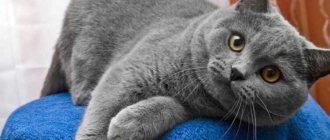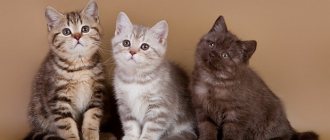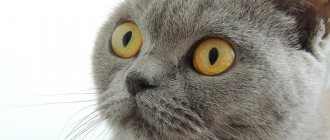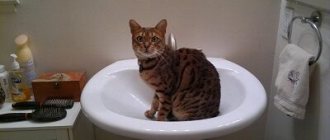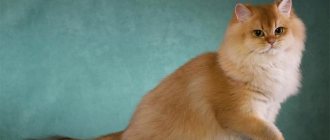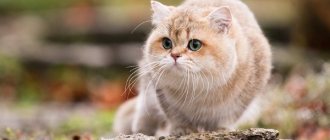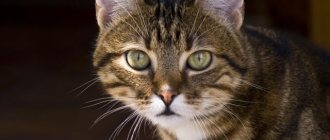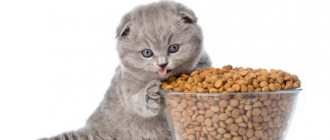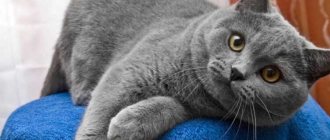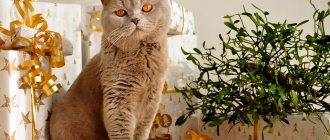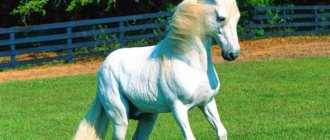Review author: “ZooVita”
The main distinguishing feature of this cat breed, from which it got its name, is its short hair, the appearance of which can be seen in the photo of a British Shorthair cat. There is no exact information about the homeland of this beautiful cat.
According to some sources, she appeared in France, while other sources claim that she is a descendant of Egyptian cats. The first exhibition at which this breed was presented took place in England in 1871.
After this exhibition, breeders and cat lovers paid attention to the British Shorthair, being impressed by the beauty of its dense coat.
The cat gained worldwide fame and distribution only in the 20th century, and was brought to the Russian Federation in 1980. Currently, the breed is popular all over the world.
Appearance of the British Shorthair cat
The description of the British Shorthair cat can begin with the fact that despite its rather large size, it has truly feline grace and elegance. This breed attracts with its beautiful, deep look and velvety coat, which is very pleasant to the touch and appearance.
If necessary, the British Shorthair can be a good hunter. The weight of representatives of the breed can range from four to eight kilograms.
He has fairly broad shoulders, a chest and a powerful body. The round and wide head has a short nose. The eyes are also round, the color of which depends on the type of breed and can be orange, blue or green.
The paws are small, but massive with thick claws. The tail has a rounded end, thickened at the base. The ears of British Shorthairs should be straight and erect, this indicates the purebred of the individual. The coat has a dense undercoat and is short and dense.
Story
The first mentions of this breed are found in ancient chronicles. There is no documented information about their origin. The first very large rat-catching cats were brought in by Roman centurions. Researchers suggest that cats were introduced by the Romans during an attack on the British Isles in 43 AD. e. In Britain they were called the “British cat”, in France - “Charteuse”, in Germany - “Carthusian cat”.
The animals were used as rodent hunters, but by the end of the 16th century, breeders paid attention to the appearance of cats. The British attended the first London cat show in 1871. Then official breed standards were adopted, and felinology began its rapid development.
The first British appeared in Russia in 1992, along with the Cartheusers, who are now called in Russia “the old type of British.”
To consolidate the unique features of the British, breeders used Persian cats - which is why British cats have a slightly flat face.
Types of colors of the British Shorthair cat
The most common color is blue. But the colors of the British Shorthair cat are very diverse:
Solid color
The cat's fur, like its skin, should be the same color. The most widely represented color is blue, but other options are possible: black, lilac, chocolate, red and white. The rarest solid colors of the British Shorthair cat are: cinnamon and fawn.
The black color combines surprisingly beautifully with yellow eyes. The lilac color is artificially bred. The value of a chocolate-colored cat becomes higher depending on the intensity of its shade.
In short-haired dogs with a red color, the intense color is considered valuable. The White British Shorthair cat is very difficult to breed and has a high risk of giving birth to offspring with defects.
The rarest color of the cat's color - "Cinnamon" - is very much appreciated by lovers of the breed. But the rarest of the colors is considered to be “Faun”. This color is valuable because it makes it possible, during breeding, to produce offspring of new light shades.
Tortoiseshell color
Basically, females are endowed with this complex and beautiful color, while males, if they have a tortoiseshell color, are sterile. Particularly appreciated is the presence of red or cream shades on the cat’s face in this color.
Silver and golden color
Cats with such a magnificent color are also called British chinchillas. The British species with this coloring is one of the rare and most expensive.
Eye color typical for silver cats: blue, lilac or green. Individuals with a golden color are considered defective if there is a gray undercoat.
Color Point
The similarity of the British Shorthair Color Point with cats of the Siamese breed is due to the characteristic coat colors: basic white in combination with black, chocolate or red.
Tabby
An amazing feature of the British Tabby color is the presence of patterns on the coat in the form of symmetrical stripes and spots on any non-primary color. Tabby cats are very similar to tigers or leopards.
"Whiskas"
A valuable type of color, characterized by clear stripes covering the entire body of the cat, is the Whiskas color. The pattern should be as clear and contrasting as possible.
Bicolor or "Harlequin"
The peculiarity of the color is the presence of two colors, the predominant of which is white. The additional color may not be uniform and may have patterns.
Owner reviews
When planning to have a puppy, many potential owners seek advice from experienced breeders. In the process of preparing this article, we talked with experienced cat owners and asked them to describe their pets in a few words.
Nina Mikhailovna about Ninel (10 years old):
A surprisingly capricious cat, but that’s what’s captivating.
She caresses only when she is hungry and begs for a treat. Sometimes he may rub against his legs in a moment of excessive tenderness. You can only hold it while walking. He likes to watch other people's activities: he will sit in a chair and move his eyes from side to side, watching your actions. Excellent quality - never bites or scratches. If small children suddenly pester her, she runs away. This is an absolutely non-vindictive animal: in ten years of keeping it, it has never harmed anyone.
She understands intonation perfectly: if you shout at her for pampering, she will only snort with displeasure, but stop the pranks, irritably walking away.
(in the photo - Nina Mikhailovna’s niece with Ninel in 2011)
Lena about her cat Kesha (5 years old):
Flexible character, calm and balanced.
When necessary, he always goes to the litter box, and sharpens his claws in a strictly defined place. It is impossible to cuddle: as soon as you take it in your arms, it immediately begins to squirm, as if in a frying pan, breaks out of your hands, runs away and defiantly turns away, showing dissatisfaction.
Occasionally allows you to pet him during an afternoon nap.
Of course, every cat is an individual, and during the time they live in the house, they develop their own behavior and habits. Only one thing can be said with confidence: having understood the character of a “plush” cat, you are imbued with sincere love for it as a friendly and flexible member of the family.
Video about the Briton
Finally, we highly recommend watching a video compilation from the life of a British cat, which very reliably conveys the dynamics of the breed’s character:
Well, as always, we will be glad if you share your personal impressions of life with these charming beauties in the comments!
Personality traits of the British Shorthair cat
Despite the fact that British Shorthair cats tolerate loneliness quite painlessly, they yearn for an absent owner. Preferring independence, cats of this breed become attached to one person.
The cat prefers to avoid strangers, occasionally responding to obsessive attention with aggression. Possessing self-esteem, representatives of the British Shorthair are extremely restrained and not intrusive.
They have a minimal need for affection from their owner. He has a calm disposition and even in the event of aggression, he does not immediately use his claws, but only warns with a blow of a soft paw.
If there is a special claw scratcher, the cat, due to its good manners, will not damage the furniture. She is very selective in choosing her favorite places, which are always central in the home.
Representatives of the breed are very playful and prefer to have several toys. They respond well to training at an early age; it is almost impossible to retrain an adult cat.
The “British” devote quite a lot of time to their appearance, carefully licking themselves throughout the day. There are no problems when toilet training a cat, since this breed is very clean and the only nuance may be the individual selection of litter for the tray.
Do the British have bad habits?
In most cases, as experienced British breeders note, the appearance of negative habits in an animal is associated with improper upbringing. Inexperienced pet owners should remember what actions the animal needs to be weaned from immediately.
- Throw objects from high surfaces to watch them fall. An extremely unpleasant habit, which the owner does not pay attention to at first, as unbreakable objects fall, but then they are replaced by vases, flower pots, and photo frames. There is no need to panic, just treat the surface where the Briton likes to play pranks several times. Any product that cats hate is suitable for this - citrus fruits or special products that can be bought at a pet store or veterinary pharmacy.
- Scratching and biting a person's hands. This happens especially often in kittens at 4 months of age, when their teeth change. It is better to offer your four-legged friend a scratching post or special toys on which to sharpen their fangs and claws.
- Love for other people's bags and packages. Although this habit is considered negative by breeders, it does not require adjustment. Often a cat can be found not only in bags belonging to friends and acquaintances, but also in bags and boxes of new shoes.
- Choosing an unusual item for the game. Unfortunately, in this case, the owner has only one correct decision - to allow him to play, since after 1-2 days the animal will forget about it.
Nutrition and care of the British Shorthair cat
Although caring for a British Shorthair cat is not tedious, it does require some time. To maintain the appearance of the coat, it is necessary to comb the cat several times a week. You should not bathe your pet more than twice a year. You need to clean your ears and trim your nails at least once a month.
The diet of this breed, like others, must be balanced and contain all the necessary vitamins and minerals. Proper nutrition will help maintain your cat's health and appearance at a high level.
It is acceptable to feed your pet prepared food, but preference should be given to reputable manufacturers. Foods containing salt and sugar can be harmful to your cat.
How to choose the right British breed pet, prices, where to buy
You should not buy a British breed kitten on the street or market. For this purpose, it is better to prefer a good certified nursery. You should choose a kitten when it is 1.5 months old to look at its color, breed, and development.
When choosing a kitten, pay attention to the following points:
- his grooming;
- activity, curiosity, playfulness;
- the kitten must be healthy and well-fed;
- The baby should not hiss or show aggression.
It’s great if when choosing a kitten you can also see its parents; they should be well-groomed, healthy, and have good natural characteristics. The origin of a purebred kitten must be confirmed by its pedigree.
The health of a kitten can be determined by the following indicators:
- clear, shiny eyes; minor discharge is allowed;
- cold and wet nose;
- clean mucous membranes;
- clean ears without black spots;
- there are no creases on the tail, its surface is smooth from beginning to end;
- wool without wounds, red spots, bald spots;
- straight teeth.
When buying a kitten of the British breed, you should know how it differs from the very similar baby of the Scottish breed.
Table: external differences between kittens of the British and Scottish breeds
| Indicator name | British | Scots |
| Body structure | Stocky, squat | More graceful lines |
| Ears | Straight, erect, slightly rounded, set at a slight angle | The Scottish Straight variety has straight ears, set more vertically, while the Scottish Fold has folded ears (dropping) |
| Head | Round, well-defined cheekbones, spreading cheeks | A clear chin, an oval muzzle reminiscent of an owl's head |
| Paws | Massive, short, which gives the impression of a heavy body | Slender paws proportional to the body |
| Tail | Rounded at the end, short | Flexible, longer tail of medium thickness |
From the litter you need to choose the most well-fed and fat kitten. Its cost will be influenced by the gender, age, pedigree, and color of the animal. On average, the price ranges from 2.5 to 10 thousand rubles. If you buy a kitten from titled parents in a nursery, the price can be significantly higher, up to 30 thousand rubles.
The plumpest kitten is chosen from a cat's litter
Photo of British Shorthair cat
Animal mating
Representatives of this breed belong to individuals with a late indicator of the development of reproductive systems.
Therefore, knitting a cat in its first year of life is strictly prohibited, because the animal may simply die. The body completes full development only by the age of 6 years.
Early mating of males before 2 years of age can lead to exhaustion, so in the future they will not be able to produce offspring.
British kittens are born completely similar to adults. Physiological features in the form of a disproportionate body are the norm for kittens. Over time, everything will return to normal, and the kitten will take on the appearance of a standard British cat.
Oriental cat - history of the breed, modern standards, character, care, nutrition + 83 photos- Maine Coon - history of occurrence, description of the breed, character + 84 photos
- Burma - a cat as a mascot, hygiene and health, character of the breed + 96 photos
